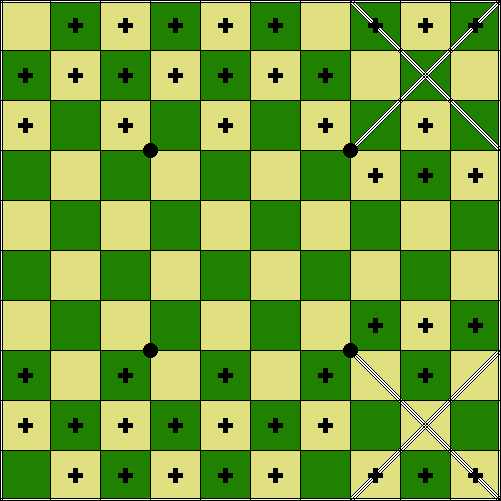For a thousand years or more, chess players of the East and West alike have extended the chess of their culture in various ways to larger boards.
Mĕirìqí attempts to blend features of the three largest branches of chess (FIDE, Shogi, and Xiangqi) into one larger-board game. The 10x10 board has been popular in Western and Islamic extensions. A look at the empty board itself suggests the combined elements.
Note the checkering of the FIDE board, the dots marking setup and promotion zones from Shogi, and the crosses (setup points) and 3X3 fortresses ('X') from Xiangqi.
This game was originally published as Glenn's Decimal Chess, with a note that it needed a better name. Peter Aronson suggested combining the sounds of CH from chess, O or ou from Shogi, and QI from Xiangqi. Unfortunately, this combination forms several less than ideal homonyms or near-homonyms in Mandarin.
This game uses 23 pieces on each side. There are 17 types, including five available only through promotion. In addition to setup and piece movements, the following rules apply.
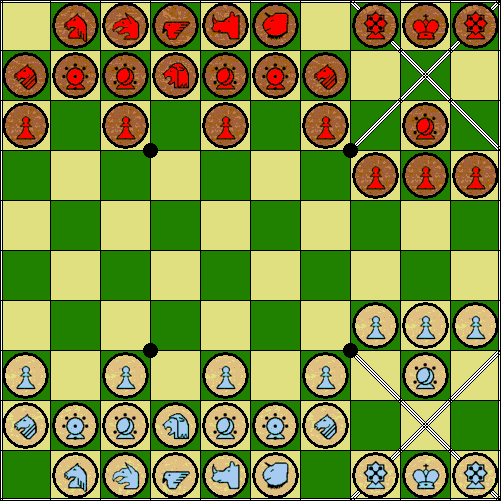 White's fortress: h1-i1-j1-h2-i2-j2-h3-i3-j3
White's fortress: h1-i1-j1-h2-i2-j2-h3-i3-j3
Black's fortress: h8-i8-j8-h9-i9-j9-h10-i10-j10
Diagram is a low-resolution version of a Zillions of Games screenshot.
Graphics by Glenn Overby II and David Howe. |
| White |
|
Black |
| a3, c3, e3, g3, h4, i4, j4 |
7 Pawns (no symbol) |
a8, c8, e8, g8, h7, i7, j7 |
| c2, e2, i3 |
3 Silvers (S) |
c9, e9, i8 |
| a2, g2 |
2 Knights (N) |
a9, g9 |
| b2, f2 |
2 Golds (G) |
b9, f9 |
| h1, j1 |
2 Mandarins (M) |
h10, j10 |
| d2 |
1 Lion (L) |
d9 |
| b1 |
1 Pegasus (P) |
b10 |
| c1 |
1 Gryphon (Y) |
c10 |
| d1 |
1 Eagle (E) |
d10 |
| e1 |
1 Rhino (H) |
e10 |
| f1 |
1 Wildebeest (W) |
f10 |
| i1 |
1 King (K) |
i10 |
a b c d e f g h i j
+---+---+---+---+---+---+---+---+---+---+
10 | | P | Y | E | H | W | | M | K | M | 10
+---+---+---+---+---+---+---+---+---+---+
9 | N | G | S | L | S | G | N | | | | 9
+---+---+---+---+---+---+---+---+---+---+
8 | + | | + | | + | | + | | S | | 8
+---+---+---+---+---+---+---+---+---+---+
7 | | | | | | | | + | + | + | 7
+---+---+---+---+---+---+---+---+---+---+
6 | | | | | | | | | | | 6
+---+---+---+---+---+---+---+---+---+---+
5 | | | | | | | | | | | 5
+---+---+---+---+---+---+---+---+---+---+
4 | | | | | | | | + | + | + | 4
+---+---+---+---+---+---+---+---+---+---+
3 | + | | + | | + | | + | | S | | 3
+---+---+---+---+---+---+---+---+---+---+
2 | N | G | S | L | S | G | N | | | | 2
+---+---+---+---+---+---+---+---+---+---+
1 | | P | Y | E | H | W | | M | K | M | 1
+---+---+---+---+---+---+---+---+---+---+
a b c d e f g h i j
+ indicates a pawn in the opening setup
|
| Fortress Pieces |
|---|
King (K) |
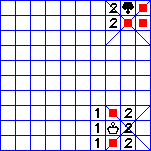 |
The King moves like he does in most versions of chess, one square in any direction. He cannot be left under attack, and if it is impossible for him to escape an attack the game is lost.
This game borrows two extra features from Xiangqi. First, the King cannot leave the marked 3x3 fortress in the corner. (Moves marked 1 in the diagram are illegal.)
Second, the two Kings cannot face each other along an open file. (Moves marked 2 in the diagram are also illegal.) Kings are restricted to a small area, yet can still help trap their counterparts.
|
Mandarin (M) |
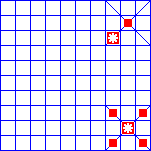 |
The Mandarin may move one square diagonally, but cannot leave the fortress in the corner. It is limited to the five squares of the 'X'.
The Mandarin comes from Xiangqi.
|
| Back-Line Beasts (non-promoting) |
|---|
Pegasus (P) |
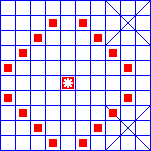 |
The Pegasus moves a total of five squares in a big 'L', in a 3+2 or 4+1 pattern. Like the Knight who it imitates, the Pegasus ignores all intervening pieces.
The Pegasus, named for a flying horse of Greek myth, comes from Glenn Overby's Beastmaster Chess.
|
Gryphon (Y) |
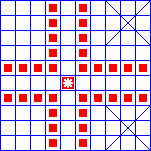 |
The Gryphon moves one square diagonally, and may then slide any number of squares outward horizontally or vertically.
The Gryphon comes from the 13th century European great chess game Grande Acedrex.
|
Eagle (E) |
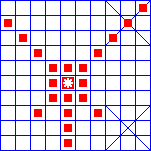 |
The Eagle combines four different moves.
- It can slide any distance diagonally forward.
- It can slide any distance straight backward.
- It can move one square straight forward or sideways.
- It can move one or two squares (without jumping) diagonally backward.
The Eagle comes from the 200-year-old Japanese variant Tori Shogi.
|
Rhino (H) |
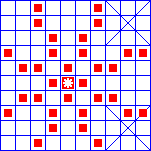 |
The Rhino has an unusual sliding move. It starts with one square horizontally or vertically. It can then turn 45 degrees outward and slide one square diagonally. It then may alternate, returning back to the original straight direction one square, then the same diagonal direction one square. This crooked rider movement may not jump pieces, but except for the odd shape is just like a regular bishop or rook, sliding any clear distance.
The Rhino was apparently invented by Ralph Betza in the mid-1990s, and reinvented independently under this name by Peter Aronson in 2001.
|
Wildebeest (W) |
 |
The Wildebeest moves like an `L`, two or three squares vertically plus one horizontally, or two or three squares horizontally plus one vertically. It hops over any pieces on the way. This combines the moves of the traditional Knight and Camel.
The Wildebeest is elsewhere known as a Gnu. It was invented for fairy chess problems, and popularized in R. Wayne Schmittberger's Wildebeest Chess.
|
| Main Battle Lines (can promote) |
|---|
Knight (N) |
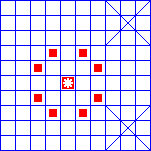 |
The Knight moves like an `L`, two squares vertically plus one horizontally, or two squares horizontally plus one vertically. It hops over any pieces on the way.
The Knight's origins are found in the earliest known chess games. It promotes to Janus.
|
Gold (G) |
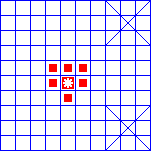 |
The Gold (general) moves one square horizontally, vertically, or forward on the diagonal.
The Gold comes from Shogi. It promotes to Rook.
|
Silver (S) |
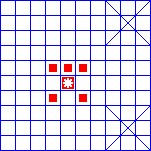 |
The Silver (general) moves one square diagonally, or one square straight forward.
The Silver comes from Shogi. It promotes to Ogyo.
|
Lion (L) |
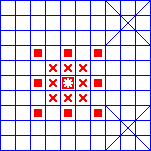 |
The Lion leaps exactly two squares horizontally, vertically, or diagonally, ignoring intervening pieces. The Lion may also capture a piece on an adjacent square, but may not move just one square without capturing.
The Lion was accidentally invented by historian H.J.R. Murray. It promotes to Queen.
|
Pawn (-) |
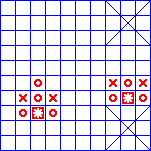 |
The Pawn has two different moves. When not capturing, it moves one square forward or sideways, but not backward. When capturing, it moves one square forward on the diagonal.
A Pawn on its own third rank has the option of moving forward two clear squares instead of one.
This Pawn blends Western and Chinese influences. It promotes to Champion.
|
| Promoted Forms (none in starting array) |
|---|
Janus (J) |
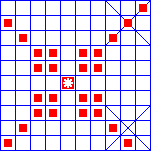 |
The Janus combines two moves. It can move like a Knight in an `L`, two squares vertically plus one horizontally, or two squares horizontally plus one vertically, hopping pieces on the way. It can instead move like a bishop, sliding any clear distance on a diagonal.
The Janus has appeared in various games under many names for the past 400 years. It is a promoted Knight in this game.
|
Rook (R) |
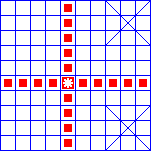 |
The Rook slides any clear distance horizontally or vertically.
The Rook is found all over the world of chess. It is a promoted Gold in this game (and in Chu Shogi as well).
|
Ogyo (O) |
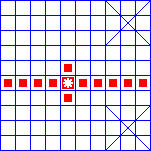 |
The Ogyo, or side mover, moves like a modern rook any number of squares horizontally without jumping, or has a one-step move vertically.
The Ogyo comes from the Japanese great chess variant Chu Shogi. It is a promoted Silver in this game.
|
Queen (Q) |
 |
The Queen slides any clear distance horizontally, vertically, or diagonally.
The Queen is found in FIDE chess and in several Shogi variants (as a Free King). It is a promoted Lion in this game.
|
Champion (C) |
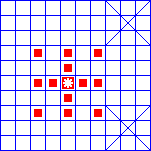 |
The Champion combines three moves. It can move one square or two squares horizontally or vertically, or exactly two squares diagonally. The two square moves ignore intervening pieces.
The Champion was invented by Daniel McDonald for his Omega Chess variant in the 1990s. It is a promoted Pawn in this game.
|

